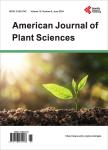Phytochemical Study and Evaluation of Cytotoxicity, Antioxidant and Hypolipidemic Properties of <i>Launaea taraxacifolia</i>Leaves Extracts on Cell Lines HepG2 and PLB985
Phytochemical Study and Evaluation of Cytotoxicity, Antioxidant and Hypolipidemic Properties of <i>Launaea taraxacifolia</i>Leaves Extracts on Cell Lines HepG2 and PLB985作者机构:Laboratoire de Physiologie Animale de Signalisation Cellulaire et de Pharmacologie FAST/Dassa Université Polytechnique d’Abomey Dassa Zoumè Bénin Laboratoire d’Etude et de Recherche en Chimie Appliquée Université d’Abomey-Calavi (LERCA/UAC) Cotonou Bénin Laboratoire d’Interactions Cellulaires et de Physiopathologie Hépatique UMR-S 1174 Université Paris Sud Paris France
出 版 物:《American Journal of Plant Sciences》 (美国植物学期刊(英文))
年 卷 期:2015年第6卷第11期
页 面:1768-1779页
学科分类:1002[医学-临床医学] 100214[医学-肿瘤学] 10[医学]
主 题:Launaea taraxacifolia Phytochemical Cytotoxicity Antioxidant Hypolipidemic
摘 要:Launaea taraxacifolia is a leafy vegetable of the family of Asteraceae (Compositae) found in several countries in West Africa including Ghana, Benin and Nigeria. The plant leaves are eaten either fresh as salad or cooked as sauces. They are also consumed as infusion to fight against several diseases including non-communicable diseases such as diabetes and hypertension. Several studies have been conducted in Ghana, Nigeria on the nutritional and medicinal values of this plant but no study has yet been conducted in Benin on the virtues of this plant. In this work we have achieved the phytochemical characterization and evaluated the cytotoxicity as well as hypolipidemic and anti-oxidant effects of the ethanol-aqueous extracts of Launaea taraxacifolia leaves. Cytotoxicity and hypolipidemic activities have been performed on HepG2 cells;the antioxidant effect has been performed on the PLB985 cells. The results showed that the ethanol-aqueous extracts of Launaea taraxacifolia leaves contained the following metabolites: catechic tannin, flavonoids, phenolic acids, mucilage and leucoanthocyanins. Only very high concentrations (20 mg/ml) of leaves extracts are toxic for HepG2 cells. Launaea taraxacifolia leaves have significant antioxidant and hypolipidemic activities.



